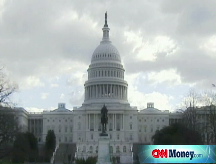Government debt prices slide
Treasurys prices slip as investors debate the Fed's intention to buy long term debt.
NEW YORK (CNNMoney.com) -- Treasury prices fell Thursday as the government continues to auction record amounts of debt and as investors consider whether or not the Fed will eventually buy longer dated securities.
The bond market has been digesting a record amount of new issuances as the government looks to fund its rescue of the economy. Wednesday evening, the House passed an $819 billion economic stimulus package that President Obama has been lobbying hard for. The bill still has to go through the Senate.
While the debt market has been expecting the expensive stimulus package to bring more supply to the Treasury pipeline, the House passage was a confirmation that the Democratically controlled Congress would quickly add to the nation's deficit, which is already expected to top $1 trillion.
Record auction: Treasury is scheduled to auction $135 billion worth of debt this week, following a $120 billion sale last week. On Thursday, a record $30 billion worth of 5-year notes went on the block.
As the government continues to spend and the deficit balloons, it will have to sell more bonds to fund its programs. The influx of supply has depressed bond prices since the start of the new year.
Bond market watchers have been anxious to know that if there will be enough buyers for the record volume of debt. If demand cannot keep pace with supply, prices will fall and yields will rise. If yields get too high, a lot of loan rates that are tied to longer term Treasury yields - like mortgage rates - will go up too.
On Tuesday, the government auctioned a record $40 billion worth of 2-year notes and $32 billion worth of 28-day bills. On Monday $29 billion worth of 13-week bills, $28 billion worth of 26-week bills, and $8 billion worth of 20-year TIPS (Treasury Inflation-Protected Securities) went up for sale.
The government depends on demand from foreign countries as it attempts to raise cash by selling Treasurys. In particular, China is a major purchaser of U.S. debt but recent comments from Tim Gethner, the new Treasury secretary, about Chinas' currency policies may hurt demand.
Stewart Taylor, senior trader of investment grade fixed income at Eaton Vance, said that the comments Tim Geithner, the new Treasury Secretary, made about China's currency came at a very bad time.
"We have this huge increase in supply and at the same time we are angering the very people who buy a significant portion of the supply and so I don't see that as a good combination," said Taylor.
Given the record volume of U.S. debt headed to market, the market may need other countries purchasing power to support prices.
Fed continues to be vague about bonds: The Federal Reserve has alluded to stepping in and buying its own debt to prop up demand, supporting prices and keeping yields in line. Market watchers were hoping to get some update to the government's plans to buy longer term Treasurys in Wednesday's monetary policy statement. But the Fed still would not spell out a clear line of action.
"The Federal Reserve continues to purchase large quantities of agency debt and mortgage-backed securities to provide support to the mortgage and housing markets," said the statement. "The Committee also is prepared to purchase longer-term Treasury securities if evolving circumstances indicate that such transactions would be particularly effective in improving conditions in private credit markets."
"There is nothing concrete still and that is where the disappointment comes in...I think people came into the meeting thinking that something more concrete is going to be announced," Taylor said.
After the Fed policy statement, long term bond prices accelerated their losses Wednesday as bond market watchers were disappointed to see a continued lack of clarity and commitment.
Debt prices: The 10-year benchmark Treasury fell 31/32 lower to 108-9/32, and its yield rose to 2.78%. Bond prices and yields move in opposite directions.
The 30-year surged 2-5/32 to 117-18/32, and its yield fell to 3.53%. The longbond sank more than 2 points Wednesday.
The 2-year note ticked down 1/32 to 99-29/32, and its yield was 0.93%
The yield on the 3-month note rose to 0.23%. The 3-month bill has been used as a short-term gauge of confidence in the marketplace because investors tend to shuffle funds in and out of the bill as they assess risk in other places - the lower the yield, the more risk they see.
Lending rates: The 3-month Libor rate held steady at 1.17% Thursday, even with Wednesday, according to data available at Bloomberg.com. The overnight Libor rate also was unchanged at 0.22%.
Libor, the London Interbank Offered Rate, is a daily average of rates that 16 different banks charge each other to lend money in London, and it is used to calculate adjustable-rate mortgages. More than $350 billion in assets are tied to Libor.
Two credit market gauges showed increased confidence in the marketplace. The so-called "TED" spread narrowed to 0.94 percentage points Thursday from 0.98 percentage points. The bigger the TED spread, the less willing investors are to take risks.
The rate surged as the credit crisis gripped the economy, but it has since fallen off as central banks around the world have lowered interest rates and pumped the economy with liquidity.
Another market indicator, the Libor-OIS spread, was unchanged at 0.95 percentage points. The Libor-OIS spread measures how much cash is available for lending between banks and is used for determining lending rates. The bigger the spread, the less cash is available for lending.
Commercial paper: A Fed report released Thursday showed that business lending contracted for the third week in a row. The amount of so-called commercial paper that was sold in the seven days ended Jan. 28 fell by $98.8 billion, or 5.9%, to a seasonally adjusted $1.59 trillion.
The Federal Reserve's Commercial Paper Funding Facility, which started in late October, allows companies to sell highly rated 3-month debt to the government in exchange for ultra-low interest rates.
Commercial paper is short-term debt that big businesses and financial institutions issue to pay for day-to-day business operations such as payroll and utilities.
The Bank of England, outlined a program Thursday in which it will buy 50 billion pounds in corporate bonds, commercial paper, and other corporate assets.
Talkback: Get your economic questions answered. E-mail realstories@cnnmoney.com with questions about jobs, housing, energy, student loans, credit cards, Americans' spending and savings habits, etc., and they could be answered on air as part of the first CNN Money Summit. ![]()





